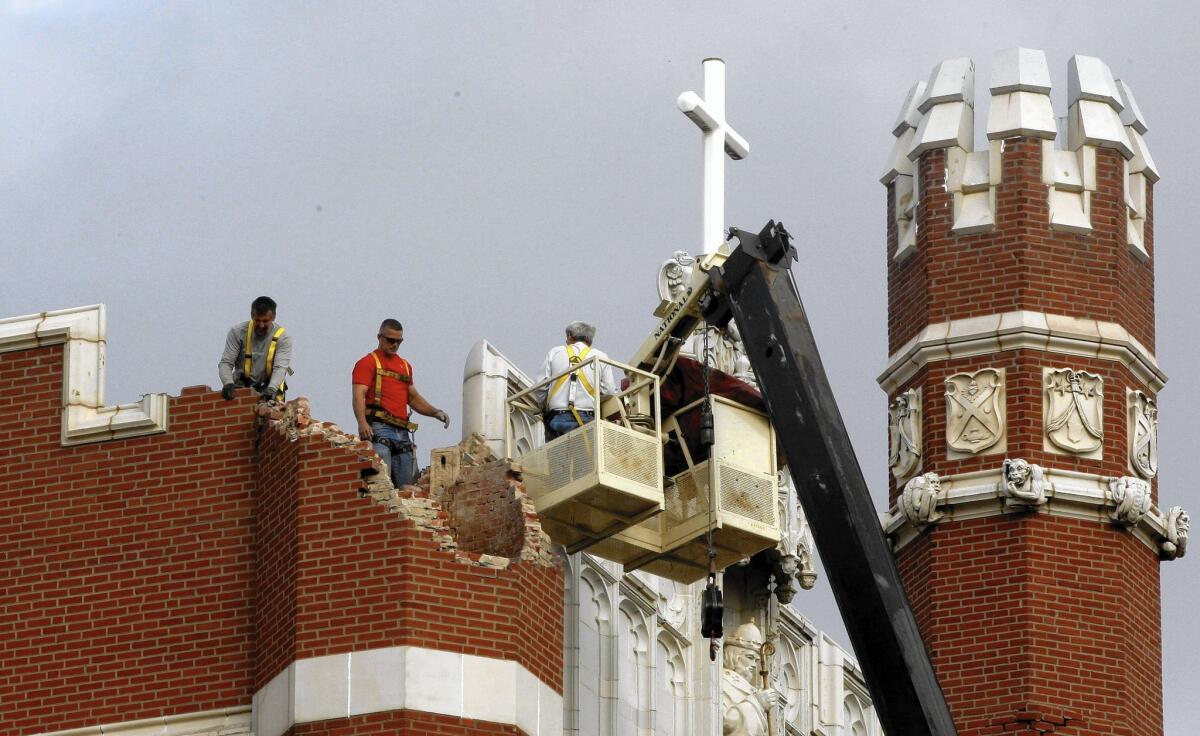Quake map puts new attention on Oklahoma, fracking wastewater

Even in an area that was becoming accustomed to earthquakes, a 5.6 temblor near Prague, Okla., in 2011 stood out. The shaking was strong enough to destroy 14 homes, cause a highway to buckle and slightly injure two people.
The initial shaking from a foreshock was felt just about 200 yards from the spot where workers had been injecting wastewater deep underground for 18 years. As the water changed the pressure underground, it triggered a seismic reaction that was felt in at least 17 states.
Oklahoma has experienced the most earthquakes thought to be triggered by human activity in the eastern and central United States, according to a new report from the U.S. Geological Survey. Last year, the state registered more quakes of magnitude 3 or higher than California.
Mark Petersen, chief of the USGS’s National Seismic Hazard Modeling Project, said the pattern is troubling.
“These earthquakes are occurring at a higher rate than ever before, and pose a much greater risk and threat to people living nearby,” said Petersen, the report’s lead author.
The USGS study, released Thursday, comes as officials begin to acknowledge that wastewater disposal is causing quakes. Hydraulic fracturing, or fracking, involves shooting a high-pressure mix of water, sand and chemicals deep underground to extract oil and natural gas. When the resulting wastewater is sent thousands of feet into the ground, it can set off earthquakes on faults that haven’t moved in a very long time.
Though man-made quakes are on the rise in states where seismic activity once was rare, the report also highlights the fact that there are areas where disposal of toxic wastewater after extracting oil is not having the same effect. By studying places where wastewater injections have not resulted in seismic activity, experts hope to find ways to continue drilling activities without disturbing faults and putting lives and property at risk.
INTERACTIVE: Detailed maps, charts of where man-made quakes are increasing
In California, wastewater wells in the Los Angeles Basin are not believed to cause earthquakes, according to Caltech seismologist Egill Hauksson, who was not involved in the USGS report. Earthquakes aren’t observed to be clustered in oil fields in Southern California, he said.
Similarly, there is no evidence of induced earthquakes in North Dakota, where part of the Bakken Shale is located, “despite very large volumes of fluid that are being disposed of,” said USGS geophysicist William Ellsworth, who worked on the new report.
The study maps 50 years of earthquake activity in 17 “induced seismicity zones” scattered across eight states. The areas highlighted on the map “are all located near deep fluid injection wells or other industrial activities capable of inducing earthquakes,” the report said.
One of them was the Raton Basin in southern Colorado and northern New Mexico. The basin saw a huge increase in the number of earthquakes beginning in 2001 after oil extraction jumped two years earlier.
By 2011, one of the region’s largest earthquakes was recorded — a magnitude-5.3 earthquake near Trinidad, Colo. USGS scientists concluded the rupture began very close to some of the largest wastewater injection wells in the basin.
Parts of Texas, Kansas, New Mexico and Ohio all have experienced more frequent quakes in the last year.
But Oklahoma leads the pack. This week, the Oklahoma Geological Survey acknowledged that the state’s sharp rise in quakes is “very unlikely to represent a naturally occurring process,” since the quakes are occurring over the same area that saw a huge jump in wastewater disposal in the last several years.
The seismicity rate in 2013 was 70 times greater than the background seismicity rate observed in Oklahoma prior to 2008, state officials said.
History suggests the area could produce a devastating quake.
“We know, for example, in Oklahoma that there was an earthquake of about magnitude 7 about 1,300 years ago,” Ellsworth said.
The idea that forcing water deep into the ground can trigger earthquakes has been discussed for decades.
In the 1960s, a geophysical observatory operated by the Colorado School of Mines detected more than 1,000 small quakes in an area near the Rocky Mountain Arsenal, where chemical-waste fluid was deposited into a 12,000-foot well. Many experts concluded that the fluid injections were responsible, according to a study at the time in the journal Science.
Scientists say they believe more research can help officials better manage the risk. Ideas include improved seismic sensors in the ground so scientists can detect smaller earthquakes.
In California, scientists say different oil extraction practices may be why earthquakes aren’t occurring due to wastewater injection here.
One factor is that the Los Angeles Basin’s petroleum deposits are thick with oil. But in Oklahoma, workers need to break up dense shale rock to get the oil out of it, Hauksson said, which results in more toxic wastewater.
Another difference: In Southern California, wastewater is generally injected back into watertight traps where the oil came from. In Oklahoma, the wastewater is disposed of outside the oil fields and injected below the groundwater aquifer, where it can trickle down and trigger movement on a long-dormant fault, Hauksson said.
Fracking has been conducted in the last few years in Southern California, including at the Inglewood and La Brea oil fields, Hauksson said, and wastewater has been injected back into the ground. But studies show that out of 1,400 disposal wells in the southern San Joaquin Valley, earthquakes were possibly related to activities at only four of them. And there’s no obvious connection between quakes and the 72 oil fields in the Los Angeles Basin.
“If you start doing stuff like in Oklahoma … then, yeah, it’s a different ballgame,” Hauksson said. “But as long as they continue current operations, we don’t expect induced seismicity in L.A.”
It’s a reasonable idea to stop injecting wastewater into deep wells if earthquakes start up, Hauksson said.
“If you’re disposing the water, and you get no earthquakes, you’re fine. But if you start getting a few small earthquakes, you should probably stop,” Hauksson said, “because if you keep going, you might get another big earthquake. It’s still a matter of research on how to do this properly.”
The USGS has observed a few places where man-made earthquakes quieted down or stopped as wastewater injections in the ground ended. One possible solution would be to redirect wastewater away from seismically sensitive areas where many people live.
Wastewater can also be transported. That process is done in parts of Pennsylvania, where the geology of much of the state is not appropriate for wastewater disposal. Wastewater from a fracking operation is recycled as much as it can be and then taken to another state such as Ohio to be injected into a well there, Ellsworth said.
Unfortunately, Ohio also is subject to human-triggered quakes. According to Ellsworth a well in the Youngstown, Ohio, area that received wastewater from Pennsylvania was thought to be responsible for creating a mangitude-4 earthquake on New Year’s Eve in 2011.
More to Read
Sign up for Essential California
The most important California stories and recommendations in your inbox every morning.
You may occasionally receive promotional content from the Los Angeles Times.













